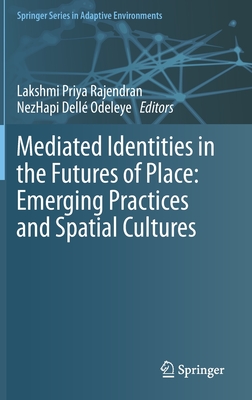Digital Ground: Architecture, Pervasive Computing, and Environmental Knowing (Paperback)
暫譯: 數位基礎:建築、普及計算與環境認知(平裝本)
Malcolm McCullough
- 出版商: MIT
- 出版日期: 2005-09-23
- 售價: $600
- 語言: 英文
- 頁數: 290
- 裝訂: Paperback
- ISBN: 0262633272
- ISBN-13: 9780262633277
-
相關分類:
交互設計 Interaction-design
立即出貨 (庫存=1)
買這商品的人也買了...
-
 Human-Computer Interaction in the New Millennium
Human-Computer Interaction in the New Millennium$2,150$2,043 -
 $600Institutionalization of Usability : A Step-by-Step Guide (Paperback)
$600Institutionalization of Usability : A Step-by-Step Guide (Paperback) -
 Voice User Interface Design
Voice User Interface Design$2,520$2,394 -
 $525Physical Computing: Sensing and Controlling the Physical World with Computers (Paperback)
$525Physical Computing: Sensing and Controlling the Physical World with Computers (Paperback) -
 Windows Server 2003 企業伺服器建構與管理實務
Windows Server 2003 企業伺服器建構與管理實務$620$484 -
 Voice Interaction Design: Crafting the New Conversational Speech Systems (Paperback)
Voice Interaction Design: Crafting the New Conversational Speech Systems (Paperback)$2,450$2,328 -
 Designing Interactive Systems: People, Activities, Contexts, Technologies (Hardcover)
Designing Interactive Systems: People, Activities, Contexts, Technologies (Hardcover)$1,200$1,176 -
 $1,020Activity-Centered Design: An Ecological Approach to Designing Smart Tools and Usable Systems (Hardcover)
$1,020Activity-Centered Design: An Ecological Approach to Designing Smart Tools and Usable Systems (Hardcover) -
 Where the Action Is: The Foundations of Embodied Interaction (Paperback)
Where the Action Is: The Foundations of Embodied Interaction (Paperback)$1,360$1,292 -
 Social Capital and Information Technology
Social Capital and Information Technology$1,360$1,292 -
 中文輸入實力養成暨評量 (2005年版)
中文輸入實力養成暨評量 (2005年版)$320$253 -
 Wired for Speech: How Voice Activates and Advances the Human-Computer Relationship (Hardcover)
Wired for Speech: How Voice Activates and Advances the Human-Computer Relationship (Hardcover)$630$599 -
 $1,490Cognitive Systems - Information Processing Meets Brain Science (Hardcover)
$1,490Cognitive Systems - Information Processing Meets Brain Science (Hardcover) -
 防網路釣魚 + 側錄 + 間諜 + 詐騙 + 毒駭
防網路釣魚 + 側錄 + 間諜 + 詐騙 + 毒駭$480$408 -
 Linux Mail Server 技術實務─架設、稽核、防毒、防垃圾信
Linux Mail Server 技術實務─架設、稽核、防毒、防垃圾信$580$493 -
 Mobile Interaction Design (Paperback)
Mobile Interaction Design (Paperback)$2,040$1,999 -
 Everyware: The Dawning Age of Ubiquitous Computing
Everyware: The Dawning Age of Ubiquitous Computing$1,460$1,387 -
 $1,400Group Cognition: Computer Support for Building Collaborative Knowledge (Hardcover)
$1,400Group Cognition: Computer Support for Building Collaborative Knowledge (Hardcover) -
 ASP.NET 2.0 深度剖析範例集
ASP.NET 2.0 深度剖析範例集$650$507 -
 $1,020Smart Materials and Technologies in Architecture (Paperback)
$1,020Smart Materials and Technologies in Architecture (Paperback) -
 Designing for Interaction: Creating Smart Applications and Clever Devices
Designing for Interaction: Creating Smart Applications and Clever Devices$1,780$1,691 -
 Designing Interactions (Hardcover)
Designing Interactions (Hardcover)$2,100$1,995 -
 $495Designing for Small Screens Studio: Mobile Phones, Smart Phones, PDAs, Pocket PCs, Navigation Systems, MP3 Players, Games Consoles (Design)
$495Designing for Small Screens Studio: Mobile Phones, Smart Phones, PDAs, Pocket PCs, Navigation Systems, MP3 Players, Games Consoles (Design) -
 Mobile Communication and Society: A Global Perspective
Mobile Communication and Society: A Global Perspective$1,020$969 -
 Making Things Talk: Practical Methods for Connecting Physical Objects
Making Things Talk: Practical Methods for Connecting Physical Objects$1,210$1,150
相關主題
商品描述
Description:
Digital Ground is an architect's response to the design challenge posed by pervasive computing. One century into the electronic age, people have become accustomed to interacting indirectly, mediated through networks. But now as digital technology becomes invisibly embedded in everyday things, even more activities become mediated, and networks extend rather than replace architecture. The young field of interaction design reflects not only how people deal with machine interfaces but also how people deal with each other in situations where interactivity has become ambient. It shifts previously utilitarian digital design concerns to a cultural level, adding notions of premise, appropriateness, and appreciation.
Malcolm McCullough offers an account of the intersections of architecture and interaction design, arguing that the ubiquitous technology does not obviate the human need for place. His concept of "digital ground" expresses an alternative to anytime-anyplace sameness in computing; he shows that context not only shapes usability but ideally becomes the subject matter of interaction design and that "environmental knowing" is a process that technology may serve and not erode.
Drawing on arguments from architecture, psychology, software engineering, and geography, writing for practicing interaction designers, pervasive computing researchers, architects, and the general reader on digital culture, McCullough gives us a theory of place for interaction design. Part I, "Expectations," explores our technological predispositions -- many of which ("situated interactions") arise from our embodiment in architectural settings. Part II, "Technologies," discusses hardware, software, and applications, including embedded technology ("bashing the desktop"), and building technology genres around life situations. Part III, "Practices," argues for design as a liberal art, seeing interactivity as a cultural -- not only technological -- challenge and a practical notion of place as essential. Part IV, "Epilogue," acknowledges the epochal changes occurring today, and argues for the role of "digital ground" in the necessary adaptation.
Malcolm McCullough is Associate Professor of Architecture and Design at the University of Michigan.
Table of Contents:
Preface ix Acknowledgements xi Introduction xiii I Expectations 1 Interactive Futures 3 2 Embodied Predispositions 27 3 Habitual Contexts 47 II Technologies 4 Embedded Gear 67 5 Location Models 97 6 Situated Types 117 III Practices 7 Designing Interactions 147 8 Grounding Places 171 9 Accumulating Value 193 IV Epilogue 10 Going Native 211 Notes 215 Further Reading 253 References 255 Index 267
商品描述(中文翻譯)
描述:
《Digital Ground》是建築師對普遍計算所提出的設計挑戰的回應。在電子時代的一個世紀後,人們已經習慣於透過網絡間接互動。但隨著數位技術無形地嵌入日常事物中,越來越多的活動變得被媒介化,網絡延伸而非取代建築。互動設計這一新興領域不僅反映了人們如何處理機器介面,還反映了人們在互動性已成為環境的一部分的情況下如何彼此互動。它將先前實用的數位設計關注轉移到文化層面,增加了前提、適當性和欣賞的概念。
Malcolm McCullough提供了建築與互動設計交集的描述,主張無所不在的技術並未消除人類對場所的需求。他的「數位基礎」概念表達了對計算中隨時隨地同質性的替代;他展示了上下文不僅塑造可用性,理想上還成為互動設計的主題,而「環境知識」是一個技術可以服務而非侵蝕的過程。
McCullough借鑒了建築、心理學、軟體工程和地理學的論點,為實踐中的互動設計師、普遍計算研究者、建築師以及對數位文化感興趣的一般讀者提供了一個互動設計的場所理論。第一部分「期望」探討了我們的技術傾向——其中許多(「情境互動」)源於我們在建築環境中的具身性。第二部分「技術」討論了硬體、軟體和應用,包括嵌入式技術(「打擊桌面」)以及圍繞生活情境建立技術類型。第三部分「實踐」主張設計作為一種自由藝術,將互動性視為文化——而不僅僅是技術——挑戰,並認為實用的場所概念是必不可少的。第四部分「後記」承認當今發生的時代變遷,並主張「數位基礎」在必要適應中的角色。
Malcolm McCullough是密西根大學建築與設計的副教授。
目錄:
前言
致謝
導言
第一部分 期望
1 互動未來
2 具身傾向
3 習慣情境
第二部分 技術
4 嵌入式裝置
5 位置模型
6 情境類型
第三部分 實踐
7 設計互動
8 確立場所
9 累積價值
第四部分 後記
10 本土化
註釋
進一步閱讀
參考文獻
索引












